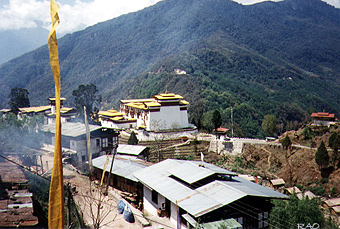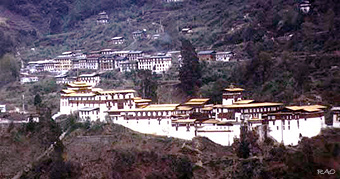 |
Bhutan's Culture - Dzongs |
|
 |
Bhutan Information |
|
|
 |
|
Trongsa
Dzong: The Druk Minjur Chhoekhor Rabtentse Dzong |
| Trongsa
Dzong: Renovation and restoration of the dzong |

|
Among
the most important sections of the dzong that were completely reconstructed
were the Minjur Lhakhang, the Zimchungsarp, the Chorten Lhakhang and the lower Drashag.
 |
| Trongsa
Dzong before the restauration |
| The portal and adjoining buildings were also
dismantled and reconstructed in their original locations by artisans from
different parts of the country.
According
to the project manager of the Trongsa Dzong Renovation Project,
Kinley Wangchuk, the renovation work had to be done very carefully because
many parts of the dzong had become fragile with age. |
|
"Most
of the structures within the dzong were adjoining the damaged areas and
had to be dismantled part by part," the manager said.
The
other renovation works included support to the portal building, drainage
in the inner courtyard, disposal drains outside the dzong, relocation of
the monks' residences, reconstruction of toilets for upper and lower Dashags,
construction of retaining walls over the slide prone areas on the western
side of the dzong and electrification work for all the renovated areas.
The
roof was also repaired, the entire dzong white washed and painted, and
the ancient frescos that decorate the dzong's walls were
restored. The project improved and relocated the tarey (horse stable) and monk body's kitchen outside the dzong to reduce the risk of
fire, constructed the Bazam (traditional bridge), the dzong security
house, renovated the Chokhor Mani, installed a Serto Jabjee
for Jam Lhakhang, electrified the Drashag adjoining the Zimchungsarp and constructed the dzong archery ground. The salt room will be
improved and lightening protection for the entire dzong installed.
| Trongsa
Dzong: History |
 |
 |
| Trongsa
Dzong before the restauration |
| A
rich history Nestled on a hill, overlooking the Mangdechu river,
the Trongsa dzong is a testimony of Bhutan's architectural heritage, political
history, rich traditions and cultures. This imposing structure, witness
to various significant events which has shaped Bhutanese history, has a
rich legacy left behind by religious and political leaders from the 16th
century onwards. |
|
The
origins of the Trongsa dzong date back to the time of Yongzin
Ngagi Wangchuk who meditated at the village of Yueli, in Trongsa in 1541,
a few kilometers above the present Dzong.
There he saw the vision of Pelden
Lhamo. One night during his meditation, Yongzin
Ngagi Wangchuk saw a butter lamp light up below the ridge of the present goenkhang housing Bhutan's guardian deities, Pelden Lhamo (Mahakali), Yeshey
Goembo, Leki Goembo.
A
visit to the site revealed the footprints of a steed and the lhatsho (scared
pond) of the guardian deity, Pelden Lhamo. Realising that the place was
a ney (sacred site) he built a meditation quarter (tshamkhang).
During his meditation a vision of the deity Pelden Lhamo appeared. This
led him to construct a small temple which he named Mondrupde. Over
the years Yongzin Ngagi Wangchuk's disciples built smaller meditation
centers near the Mondrupde lhakhang which soon began to resemble a small
village. The people of Yueli named this new settlement Trong-sar
(meaning a new village).
In 1647, Chhoeje
Minjur Tenpa was appointed by Zhabdrung Ngawang Namgyel as the
first Trongsa Penlop and Shabdrung's representative to Trongsa.
On the instructions of the Zhabdrung he constructed the dzong which
resembled a fort and housed various lhakhangs. He also built the
present goenkhang on the same spot where Yongzin Ngagi Wangchuk saw his vision.
The
dzong was later named Druk Minjur Choekhor Rabten Tse by Chhoeje Minjur
Tenpa which translated into "the Dzong,
built on the tip of a dungkhar (conch), of the never changing country of
Druk where the dharma is everlasting".
Chhoeje
Minjur Tenpa is also credited for the extension of the dzong in 1652,
with the construction of the Poekhang or Minjur Lhakhang and at
the end of the 17th century Desi
Tenzin Rabgye expanded the dzong. Desi
Tenzin Rabgye consecrated the Goenkhang of Pelden Lhamo and Yeshey Goembo in 1667.
In 1751,
Penlop Druk Dendrup built the Chenreyzig Lhakhang and in 1765 the Trongsa Penlop, Zhidar, established the Trongsa Rabdey dratshang with about 50 monks. In 1927King
Jigme Wangchuck renovated the Chenreyzig
Lhakhang.
In 1853,
the tenth Trongsa Penlop, Jigme Namgyel, built the Dechhog Lhakhang in the central section of the Dzong. According to legend, prior to the
consecration of the Dechhog image and the Dechhog Lhakhang,
two disciples of Lam Jangchu Tsindup arrived from Tibet with
the sacred self created (rangjung) image of Dorji Phagmo, one of the
21 Rangjung Kharsa Pani, a religious relic formed miraculously from
the spinal bone of Tsangpa Jarey, the patriarch of the Drukpa
Kargyue sect. The sacred rangjung was offered to Trongsa Penlop
Jigme Namgyel and is today housed in a Gaw (amulet) placed at
the center of a life size silver image of the Dorje Phagmo in the Dechhog
Lhakhang.
In
all, the dzong has 25 lhakhangs, including the Chorten Lhakhang built by Yongzin Ngagi Wangchuk in 1543,
housing sacred images and religious treasures and the intricate wood carvings
and beautiful frescos that decorate the walls and pillars are a testimony
to Bhutan's rich religious and culture traditions.
Today,
more than 460 years after it was established as a meditation quarter, the dzong is a magnificent
example of ancient traditional Bhutanese construction techniques and aestheticism.
 |
| Contributed
By
Rinzin Wangchuk, Kuensel, Bhutan's National Newspaper |
| Information on Bhutan |
 |
|




